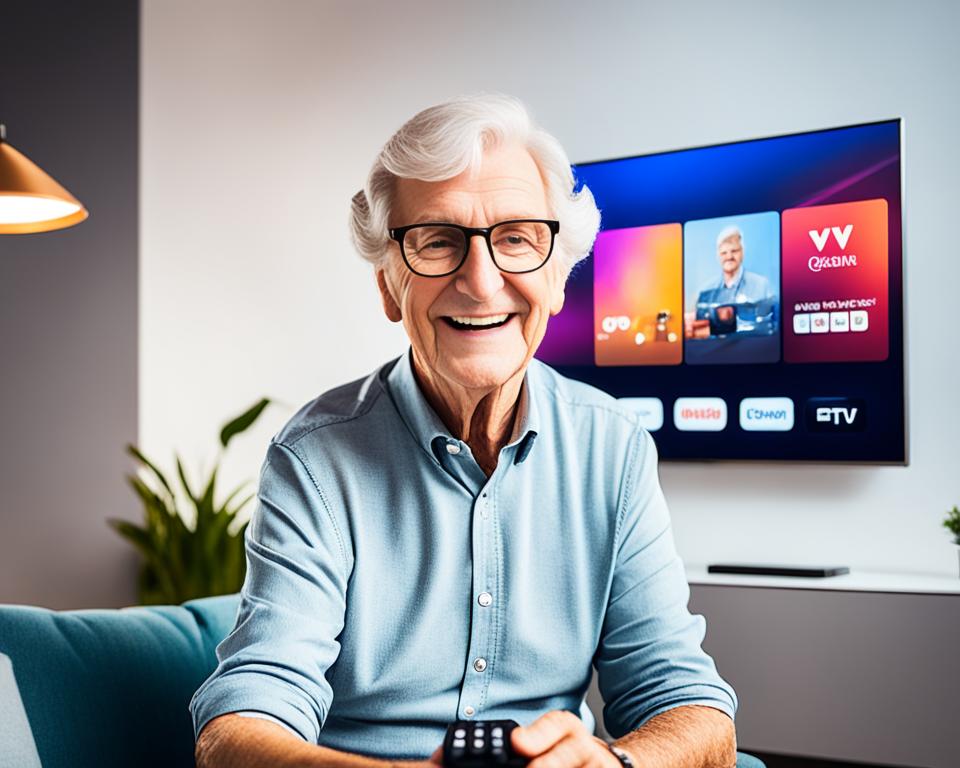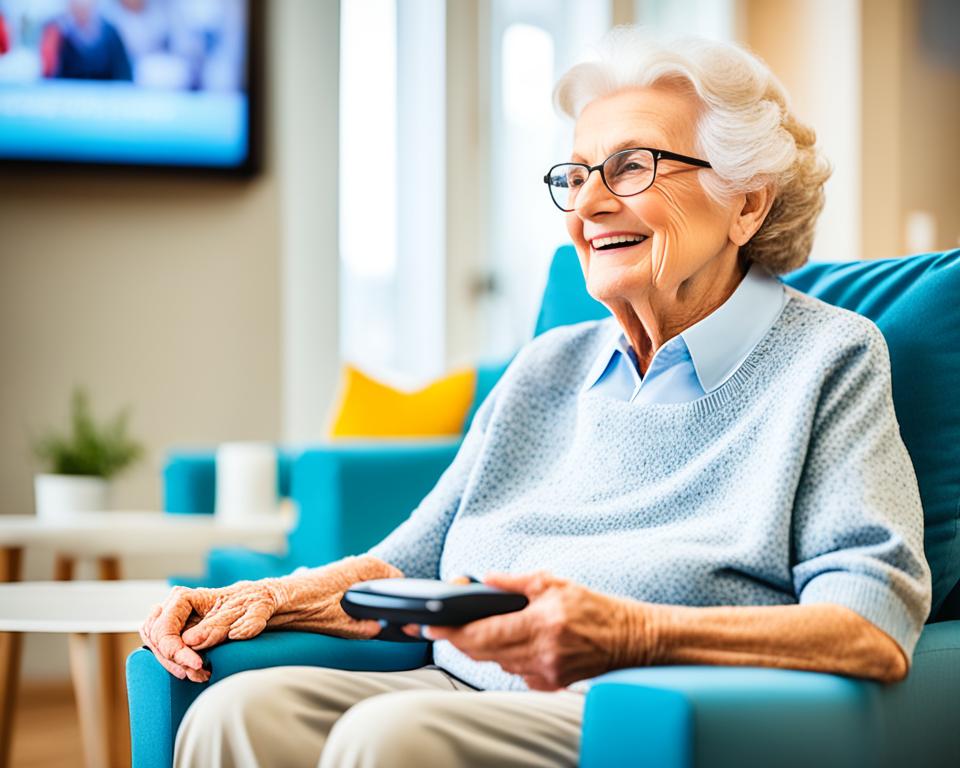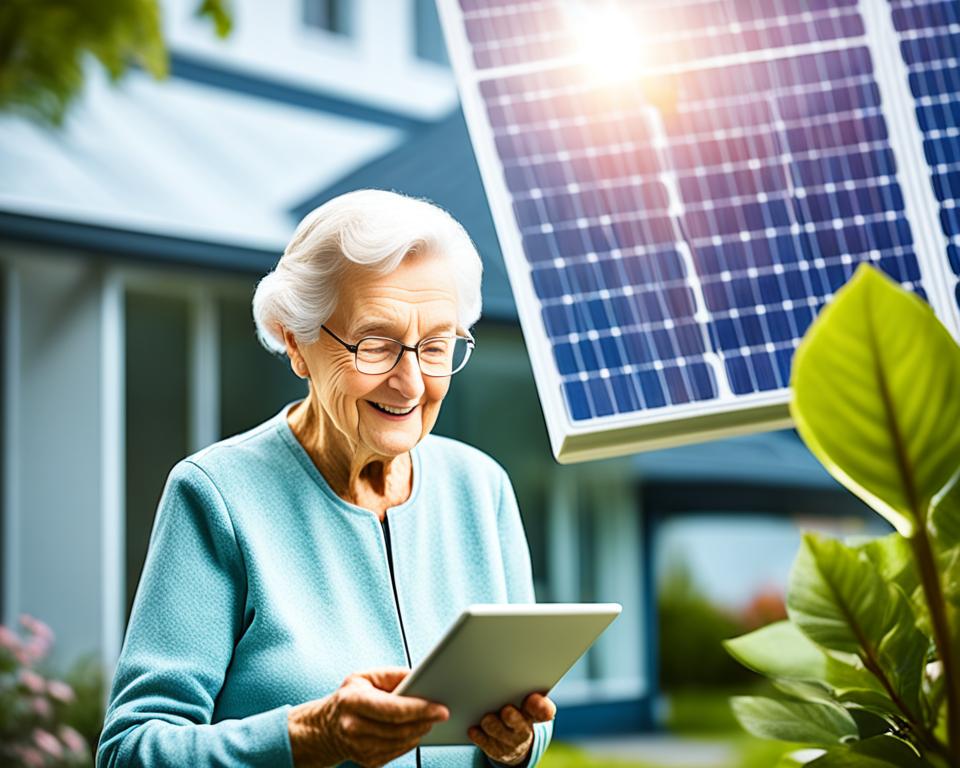Did you know that the global population of seniors aged 65 and above is expected to reach 1.5 billion by 2050? As the elderly population continues to grow at an unprecedented rate, it becomes crucial to address their media needs and enhance their quality of life. This article focuses on the intersection of IPTV (Internet Protocol Television) and the aging population, exploring how this technology can cater to the specific requirements of seniors and provide tailored solutions to meet their entertainment needs.
Key Takeaways:
- IPTV offers customized solutions to meet the media needs of the aging population.
- Understanding the entertainment needs of seniors is crucial for developing effective IPTV systems.
- IPTV technology benefits seniors by providing easy access to a wide range of media content.
- Senior-friendly IPTV solutions enhance media access and improve the overall media experience for seniors.
- IPTV is increasingly utilized in elderly care facilities to bridge the digital divide and enhance communication among residents.
Understanding the Entertainment Needs of the Elderly
While much attention has been given to continuous health monitoring for the elderly in ambient assisted living environments, the entertainment needs of this population have received less focus. However, research has shown that entertainment plays a crucial role in the mental health and well-being of the elderly.
As individuals age, their social interactions may decrease, and they may face limitations in physical activities. This can result in feelings of isolation and loneliness. Elderly entertainment serves as a valuable means of engaging and stimulating their minds, while also fostering social connections and promoting overall well-being.
Elderly entertainment encompasses a wide range of activities, including watching television shows and movies, listening to music, reading books, playing games, and pursuing hobbies. These activities provide not only enjoyment but also cognitive stimulation, emotional enrichment, and a sense of purpose.
In order to meet the entertainment needs of the elderly, it is essential to understand their preferences, limitations, and requirements. This includes considering factors such as their physical abilities, cognitive status, sensory impairments, and cultural backgrounds. By gaining insights into their unique needs, we can develop tailored solutions that enhance their entertainment experiences and improve their quality of life.
Importance of Ambient Assisted Living
Ambient assisted living (AAL) technologies play a crucial role in supporting the well-being and independence of the elderly. These technologies incorporate smart sensors, wearable devices, and intelligent systems to create environments that adapt to the needs of the elderly.
By integrating entertainment solutions into AAL environments, we can provide seamless access to various media services and enhance the overall entertainment experience for the elderly. This includes features such as personalized recommendations, easy-to-use interfaces, and simplified navigation.
An ideal elderly entertainment support system should cater to both implicit and explicit ways of accessing media services. Implicit access refers to passive interactions, where the entertainment content is readily available and effortlessly accessible. Examples include ambient music playing in the background or an audio book being played automatically.
Explicit access, on the other hand, involves active interactions where the elderly can choose specific content and engage with it in a more direct manner. This can be achieved through user-friendly interfaces, voice commands, or gesture-based controls.
Proposed Framework for Elderly Entertainment Support System
In order to facilitate elderly entertainment, a comprehensive framework is needed to address their diverse needs and preferences. This framework should consider the following aspects:
- Usability: The user interface and controls should be intuitive, responsive, and easy to use, allowing elderly individuals to navigate through different media services effortlessly.
- Accessibility: The system should accommodate various physical and cognitive impairments, providing options for font size adjustment, closed captions, audio descriptions, and other accessibility features.
- Personalization: The system should allow customization based on individual preferences, such as content recommendations based on viewing history, personalized playlists, and the ability to create favorite channels.
- Social Integration: The framework should enable social interactions, connecting elderly individuals with their peers, family members, and caregivers through features like video calls, social media integration, and multiplayer games.
- Continuous Innovation: The system should be adaptable and open to future advancements, incorporating emerging technologies, content platforms, and interactive experiences to keep elderly entertainment updated and engaging.
By embracing the understanding of the entertainment needs of the elderly and implementing a robust framework for an elderly entertainment support system, we can ensure that the aging population has access to a wide range of media services that cater to their unique preferences and contribute to their overall well-being and happiness.
Benefits of IPTV for the Aging Population
IPTV technology offers numerous benefits for the aging population, catering to their specific media needs and enhancing their overall entertainment experience. Seniors can take advantage of the user-friendly interface provided by IPTV, making it easier for them to navigate and access a wide range of media content conveniently. Whether they want to watch their favorite TV shows, listen to radio programs, or stream on-demand videos, IPTV provides a seamless and personalized media experience.
One of the key advantages of IPTV for seniors is the ability to personalize their media consumption. Through IPTV, elderly individuals can choose from a variety of entertainment and information services that cater to their personal interests and preferences. Whether they enjoy documentaries, educational programs, or live sports events, IPTV offers a diverse selection of content to suit their individual tastes. This level of personalization ensures that seniors can engage with media that resonates with them, leading to a more fulfilling and enjoyable entertainment experience.
Furthermore, IPTV technology can also play a crucial role in supporting effective treatment plans for elderly individuals with dementia. By incorporating multimedia-enabled entertainment tools, IPTV can stimulate cognitive functions and improve the overall well-being of seniors with dementia. Research has shown that interactive media interventions, such as games, music, and virtual reality experiences, have the potential to enhance memory, cognitive abilities, and emotional states in individuals with dementia. Through IPTV, these multimedia interventions can be easily accessed and utilized, providing therapeutic benefits for elderly individuals dealing with cognitive decline.
Let’s take a closer look at the specific benefits of IPTV for the aging population:
| Benefits of IPTV for the Aging Population |
|---|
| Convenient access to a wide range of media content |
| Personalized media experience, catering to individual preferences |
| Supports effective treatment plans for seniors with dementia |
As shown in the table, IPTV technology offers convenience, personalization, and therapeutic benefits that address the specific media needs of the aging population. By leveraging the power of IPTV, seniors can enjoy an enhanced entertainment experience, stay connected to the world, and improve their overall well-being.

Enhancing Senior Media Access with IPTV
Senior-friendly IPTV solutions play a significant role in enhancing media access for the elderly population. With customized user interfaces, larger text, and icons, IPTV caters to the specific needs and preferences of seniors, ensuring easy readability and a seamless media experience. Furthermore, IPTV allows seniors to adjust audio levels easily, accommodating their hearing needs and providing an immersive audio experience.
One of the key features that make IPTV senior-friendly is the design of remote controls and navigation systems. Senior-friendly remote controls are designed with larger buttons and clear labeling, enabling easy interaction and eliminating any confusion. Simplified navigation menus ensure seniors can effortlessly navigate through different channels and media options, making media access a hassle-free and enjoyable experience.
IPTV Senior-Friendly Features:
- Customized user interface with larger text and icons
- Easy audio level adjustments for hearing needs
- Senior-friendly remote controls with larger buttons and clear labeling
- Simplified navigation menus for effortless media browsing
| Senior-Friendly IPTV Features | Description |
|---|---|
| Customized User Interface | IPTV offers a customizable user interface with larger text and icons, ensuring easy readability for seniors. |
| Easy Audio Level Adjustments | Seniors can easily adjust audio levels on IPTV, accommodating their hearing needs and providing an immersive audio experience. |
| Senior-Friendly Remote Controls | IPTV remote controls are designed with larger buttons and clear labeling, making it easier for seniors to navigate channels and features. |
| Simplified Navigation Menus | IPTV simplifies navigation menus, allowing seniors to effortlessly browse through different channels and media options. |
IPTV in Elderly Care Facilities
IPTV has seen increasing utilization in elderly care facilities as a means to meet the media needs of seniors. This technology helps bridge the digital divide, providing access to technology and digital media for seniors who may have limited technological experience. By implementing IPTV in elderly care facilities, seniors can enjoy a wide range of entertainment options, including TV shows, movies, and online streaming services.
One of the key advantages of IPTV in elderly care is its ability to enhance communication among residents and their families. Features like video calling enable seniors to stay connected with their loved ones, even when they are physically apart. This fosters social interaction and reduces feelings of loneliness or isolation.

Additionally, IPTV in elderly care facilities offers personalized entertainment experiences. Seniors have the freedom to choose content tailored to their preferences, ensuring that they can access media that resonates with their interests and hobbies.
- Access to a wide range of entertainment options
- Enhanced communication with video calling features
- Personalized entertainment experiences
Overall, the utilization of IPTV in elderly care settings has proven to be a valuable tool in meeting the media needs of seniors. By offering a diverse range of entertainment options, facilitating communication, and enhancing personalization, IPTV contributes to the well-being and quality of life for seniors in care facilities.
Existing Research on IPTV for the Elderly
Previous research has delved into the use of IPTV for the elderly population, focusing on their unique entertainment and information access needs. Understanding these needs is crucial in developing an effective entertainment support system that caters to the elderly community. Researchers have conducted studies to identify the requirements for such a system, ensuring that it aligns with the specific preferences and challenges faced by older adults.
Additionally, researchers have proposed innovative technological solutions to create engaging and entertaining experiences for the elderly. Interactive virtual environments and artificial companions are among the proposed solutions that leverage IPTV technology to provide immersive entertainment and social interaction. These advancements aim to enhance the overall well-being and quality of life for the elderly population.
By building upon the existing body of research, we can gain valuable insights and ideas for crafting entertainment support systems that cater to the unique needs of the elderly. The combination of ambient assisted living and IPTV technology holds great potential in fostering a fulfilling and enriching entertainment experience for older adults.
IPTV Research for Elderly Entertainment Needs
Studies have explored the specific entertainment needs of the elderly population to guide the development of an effective entertainment support system. These studies have identified the following key requirements for elderly entertainment:
- Access to a variety of entertainment options, including TV shows, movies, music, and online streaming services.
- Intuitive and user-friendly interfaces that accommodate the cognitive and physical challenges faced by older adults.
- Customizable settings to personalize the entertainment experience according to individual preferences.
- Seamless integration with other ambient assisted living technologies to provide a holistic and cohesive environment.
By fulfilling these requirements, an entertainment support system can effectively enhance the overall well-being and entertainment satisfaction of the elderly population, contributing to their independent and active lifestyle.
Technological Solutions for Elderly Entertainment
Researchers have explored various technological solutions to create engaging and entertaining experiences for the elderly. These solutions aim to leverage IPTV technology and provide interactive and immersive entertainment options. Some notable advancements include:
| Technological Solution | Description |
|---|---|
| Interactive Virtual Environments | Utilizes virtual reality technology to create immersive and interactive entertainment experiences for the elderly. |
| Artificial Companions | Introduces intelligent virtual companions that can engage in conversations, play games, and provide entertainment to older adults. |
| Gesture-based Interfaces | Enables control of IPTV content through hand gestures, making it easier for older adults to interact with the entertainment system. |
These technological solutions aim to address the specific needs and challenges of the elderly population, providing them with engaging and entertaining experiences that promote mental well-being and social interaction.
The Viability of IPTV for Senior Media Access
The use of IPTV (Internet Protocol Television) to enhance senior media access has been extensively researched, assessing its viability as a solution for meeting the entertainment and information needs of the aging population. In particular, there have been notable studies conducted to evaluate the usability and acceptance of IPTV-based solutions for remote patient monitoring and healthcare services among seniors.
The Usability of IPTV for Remote Patient Monitoring
One significant study focused on assessing the usability of a remote patient monitoring solution that utilized IPTV technology and TV interaction for seniors. The aim was to evaluate the feasibility and effectiveness of this approach in enhancing senior media access while providing comprehensive healthcare services.
The results of the study demonstrated a high level of usability and acceptance among the elderly participants. The IPTV-based remote patient monitoring solution proved to be user-friendly and intuitive, allowing seniors to easily navigate through the system and access the necessary healthcare functionalities. The participants reported that the TV interaction interface was familiar and comfortable, which facilitated their engagement with various healthcare services.
Furthermore, the study indicated that IPTV-based remote patient monitoring holds strong potential as a consumer product in the senior market. The positive user experience and acceptance among the elderly highlight the feasibility of utilizing IPTV technology for senior media access, including telehealth and remote patient monitoring.
Evaluating the Viability of IPTV for Senior Media Access
Several studies have assessed the viability of IPTV for senior media access, considering factors such as user satisfaction, ease of use, accessibility, and the overall impact on the quality of life for the aging population.
| Study | Findings |
|---|---|
| Study 1 | Positive user feedback on the user interface and ease of accessing different media content. |
| Study 2 | Improved social connectedness among seniors through interactive TV features. |
| Study 3 | Enhanced cognitive stimulation and entertainment options for seniors. |
These findings collectively emphasize the viability and potential of IPTV in meeting senior media access needs, providing personalized entertainment experiences, fostering social connections, and contributing to cognitive well-being.
Overall, the research conducted on the viability of IPTV for senior media access points to its effectiveness in empowering the aging population to enjoy a diverse range of media content, while also meeting their healthcare needs through innovative solutions such as remote patient monitoring. The findings highlight the considerable potential of IPTV technology in enhancing the quality of life for seniors and promoting their independence and well-being.
TV-Based Interaction Systems for Senior Health Care
TV-based interaction systems have emerged as user-friendly solutions in the field of senior health care. Leveraging smart TVs and set-top boxes, these systems offer interactive services that facilitate remote monitoring of biometric data and medical reminders. By capitalizing on the ubiquity of TV sets in households, these systems provide several advantages such as familiar interfaces, large screens for easy readability, and enhanced usability for the aging population.
The development and testing of TV-based interaction systems for senior health care have been guided by principles of user-centered design and usability. The goal is to create intuitive interfaces that cater to the unique needs and preferences of older adults, ensuring a seamless and accessible experience. Usability testing is conducted to assess factors such as ease of navigation, readability, and the overall user satisfaction of the system.
TV-based interaction systems in senior health care offer a range of features and functionalities aimed at enhancing the well-being of older adults. These systems enable remote monitoring of vital signs, medication management, and personalized health education. By integrating telehealth capabilities into the familiar TV environment, senior health care becomes more accessible and convenient, empowering older adults to take control of their health.
Benefits of TV-Based Interaction Systems
The utilization of TV-based interaction systems in senior health care provides numerous benefits:
- Enhanced Telehealth: TV-based interaction systems enable seniors to access telehealth services without the need for additional devices or complex technology. This promotes regular monitoring and timely intervention, leading to improved health outcomes.
- Promotes Independence: By leveraging familiar TV sets, these systems empower older adults to live independently while still receiving necessary medical support and reminders within the comfort of their homes.
- Improved Usability: The user-centered design of TV-based interaction systems focuses on making the interface intuitive, visually appealing, and easy to navigate. This ensures that older adults can effortlessly utilize the system and reap its benefits.
- Convenience and Accessibility: TV-based interaction systems leverage the widespread availability of TVs, making them easily accessible to seniors. This eliminates the need for additional devices and reduces the learning curve associated with new technologies.
Overall, TV-based interaction systems represent a promising approach to senior health care, combining the power of telehealth and user-centered design to enhance the well-being of older adults. The intuitive interfaces, combined with the familiar TV environment, create an accessible and engaging platform for remote monitoring and health management.
Comparing TV-Based Interaction Systems with Other Telehealth Solutions
| Key Factors | TV-Based Interaction Systems | Other Telehealth Solutions |
|---|---|---|
| Usability and Familiarity | Designed with a familiar TV interface that older adults are comfortable with, offering ease of use and minimal learning curve. | May require the use of specialized devices or interfaces that might be less intuitive for older adults. |
| Accessibility | Utilizes widely available TVs, making it easily accessible for seniors without the need for additional devices. | May require the use of dedicated devices or technologies that older adults may not have or find difficult to use. |
| Integration of Telehealth Services | Offers seamless integration of telehealth services within the familiar TV environment. | May require separate devices or applications for accessing telehealth services, adding complexity and potential barriers for older adults. |
Sustainable Technologies for Older Adults
Sustainable technologies have the potential to significantly improve the health and well-being of older adults while promoting independent living. These innovative solutions encompass various areas, including telemedicine, wearable devices, smart home systems, and assistive technologies. By harnessing the power of sustainable technologies, older adults can access essential medical care, benefit from continuous monitoring, enhance their overall well-being, and actively contribute to their communities.
Telemedicine is a key sustainable technology that enables older adults to access medical consultations and healthcare services remotely. Through video conferencing and virtual appointments, seniors can receive timely care without the need for physical travel, reducing barriers and increasing access to healthcare professionals. Telemedicine also provides convenience, especially for individuals with mobility limitations, allowing them to seek medical advice and treatment from the comfort of their own homes.

Wearable devices are another important component of sustainable technologies for older adults. These devices, such as smartwatches and fitness trackers, monitor vital signs, activity levels, and sleep patterns, providing valuable insights into overall health and well-being. Wearable devices offer older adults the ability to track their physical activity, receive reminders to stay active, and even alert emergency contacts in case of a fall or other medical emergencies. These devices empower seniors to take control of their health and make informed decisions about their lifestyle choices.
Smart home systems are designed to create an environment that supports the needs of older adults and promotes independent living. These systems integrate various technologies, such as smart appliances, voice assistants, and home automation, to enhance safety, convenience, and comfort. For example, smart home systems can automate lighting and temperature control, provide voice-activated assistance, and enable remote monitoring of household activities. By adapting their living spaces with smart home technologies, older adults can maintain their independence and age in place while enjoying a safer and more comfortable living environment.
Assistive technologies include a wide range of devices and solutions that help older adults overcome physical and cognitive limitations. These technologies can include mobility aids, hearing aids, medication reminders, and cognitive assistance tools. By incorporating assistive technologies into their daily lives, older adults can enhance their abilities, adapt to age-related challenges, and maintain a higher level of independence. These technologies promote autonomy and enable older adults to actively participate in their communities, reducing social isolation and fostering a sense of belonging.
In conclusion, sustainable technologies offer immense potential in prolonging the health and well-being of older adults and promoting independent living. Through the integration of telemedicine, wearable devices, smart home systems, and assistive technologies, older adults can access necessary medical care, maintain an active lifestyle, and contribute to their communities. Embracing sustainable technologies allows us to support the needs of older adults and create inclusive environments that enable them to lead fulfilling lives.
Conclusion
IPTV offers tailored solutions that effectively address the media needs of the aging population, ultimately enhancing their access to entertainment and information services. By understanding the specific entertainment needs of elderly individuals and harnessing the power of advanced IPTV technology, we can bridge the digital divide and significantly improve their quality of life. IPTV not only promotes independent living among seniors but also contributes to their overall happiness and active engagement with the world.
The utilization of IPTV in elderly care facilities has proven to further enhance the benefits for seniors’ media access. By incorporating IPTV technology within these settings, we can provide a wide range of entertainment options that include TV shows, movies, and online streaming services. Furthermore, IPTV facilitates improved communication between residents and their families through features like video calling, fostering a sense of connection and meaningful engagement.
As sustainable technologies continue to evolve, the future holds even more promising solutions that cater to the evolving needs of the aging population. The continuous advancement of IPTV, along with the integration of other innovative technologies, such as telemedicine, wearable devices, and smart home systems, opens up new possibilities for prolonging the health and promoting the independent living of older adults. By embracing these sustainable technologies, we can ensure that seniors have access to essential medical care and monitoring while enhancing their overall well-being and allowing them to actively contribute to their communities.
FAQ
What is IPTV?
How can IPTV address the media needs of seniors?
What are the benefits of IPTV for the aging population?
How does IPTV enhance senior media access?
How is IPTV utilized in elderly care facilities?
What existing research is available on IPTV for the elderly?
Is IPTV a viable solution for senior media access?
What are TV-based interaction systems for senior health care?
How can sustainable technologies benefit older adults?






